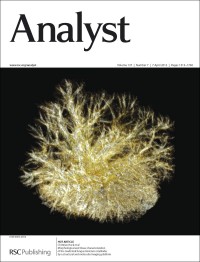Our latest issue is now online, with three excellent cover articles for you to enjoy.
The dramatic front cover features work from Leon Barron and colleagues at King’s College London. They used capillary-scale ion chromatography and suppressed conductivity detection to probe gunshot residue, sweat and latent fingerprints in order to detect low molecular weight anions at the fg–pg level.
The technique was sensitive enough to reveal differences between the sweat of smokers and non-smokers, based on elevated levels of thiocyanate and benzoate in non-smokers. The analysis of latent fingerprints showed that contact with Pyrodex, often used as a propellant in muzzle loading rifles, resulted in higher levels of benzoate, nitrate and perchlorate compared to the control.
They hope their work will help with the development of new methods for gunshot residue classification, to overcome problems with existing methods.
Probing gunshot residue, sweat and latent human fingerprints with capillary-scale ion chromatography and suppressed conductivity detection
Elizabeth Gilchrist, Norman Smith and Leon Barron
Analyst, 2012, 137, 1576-1583
DOI: 10.1039/C2AN16126E
On the inside front cover is a 3-D reconstruction of a mature Hericium basidioma by Christian Huck of Leopold-Franzens University, Austria, and co-workers.
They have evaluated new imaging techniques to study morphological and molecular patterns of the potential medicinal fungus Hericium coralloides, and demonstrate that the combination of different spectroscopic methods enables to gain a more distinct picture concerning morphology and distribution of active ingredients. German-speaking readers can find out more here.
Morphological and tissue characterization of the medicinal fungus Hericium coralloides by a structural and molecular imaging platform
J. D. Pallua, W. Recheis, R. Pöder, K. Pfaller, C. Pezzei, H. Hahn, V. Huck-Pezzei, L. K. Bittner, G. Schaefer, E. Steiner, G. Andre, S. Hutwimmer, S. Felber, A. K. Pallua, A. F. Pallua, G. K. Bonn and C. W. Huck
Analyst, 2012, 137, 1584-1595
DOI: 10.1039/C1AN15615B
On the back cover, Guoliang Huang of Tsinghua University School of Medicine, and colleagues have developed a deep ultraviolet-visible (DUV-Vis) reflected optical fiber sensor for use in a simple spectrophotometric detection system to detect illegal drugs.
Six different drugs were quantified at concentrations from 16 pg to 0.16 μg, and the authors say this rapid and accurate analytical method has wide-ranging applications in forensic science, law enforcement, and medicine.
Rapid and on-site analysis of illegal drugs on the nano–microscale using a deep ultraviolet-visible reflected optical fiber sensor
Qiang Li, Tian Qiu, Hongxia Hao, Hong Zhou, Tongzhou Wang, Ye Zhang, Xin Li, Guoliang Huang and Jing Cheng
Analyst, 2012, 137, 1596-1603
DOI: 10.1039/C2AN15953H
All three cover articles will be free to access for 6 weeks.













